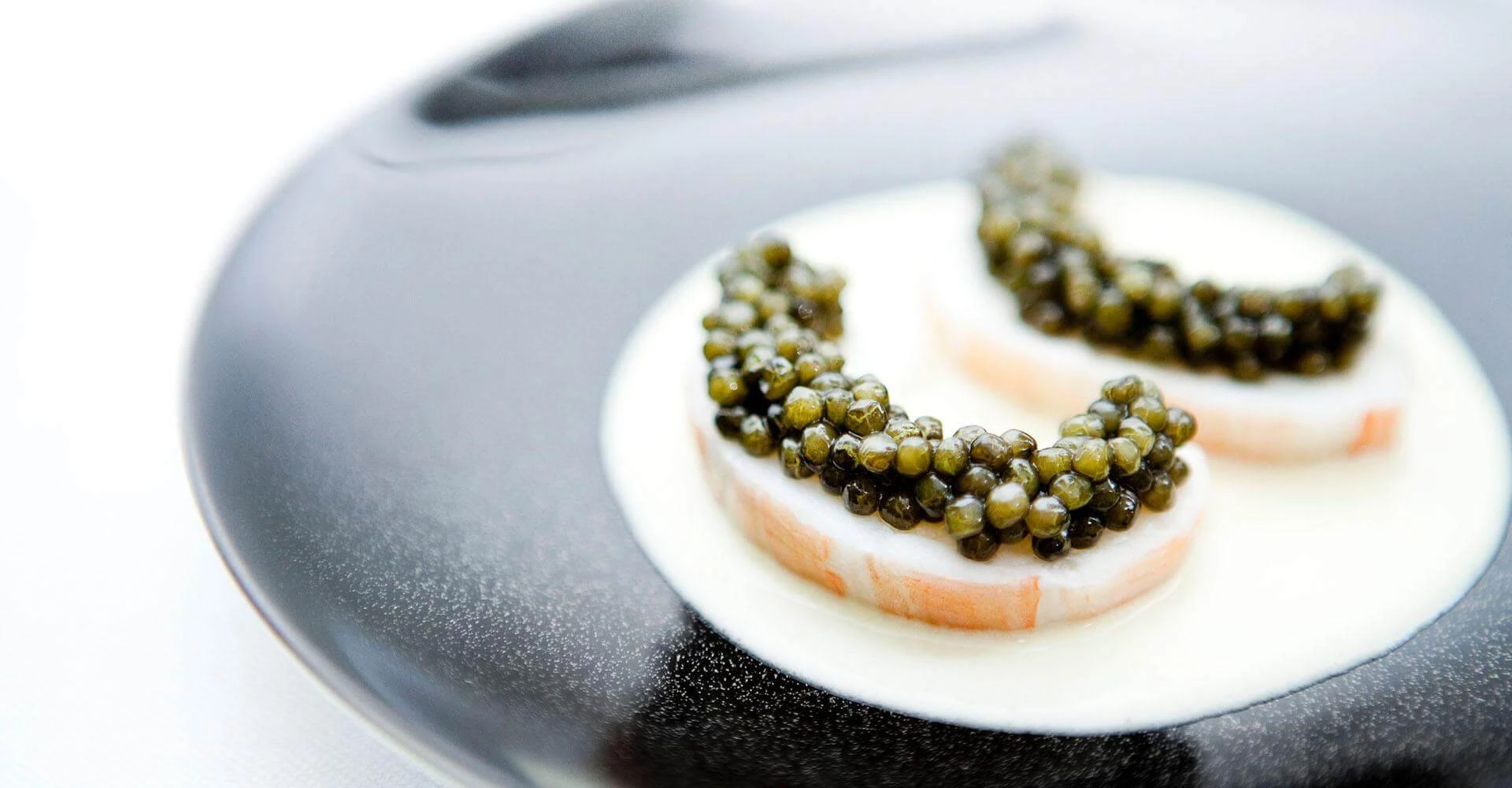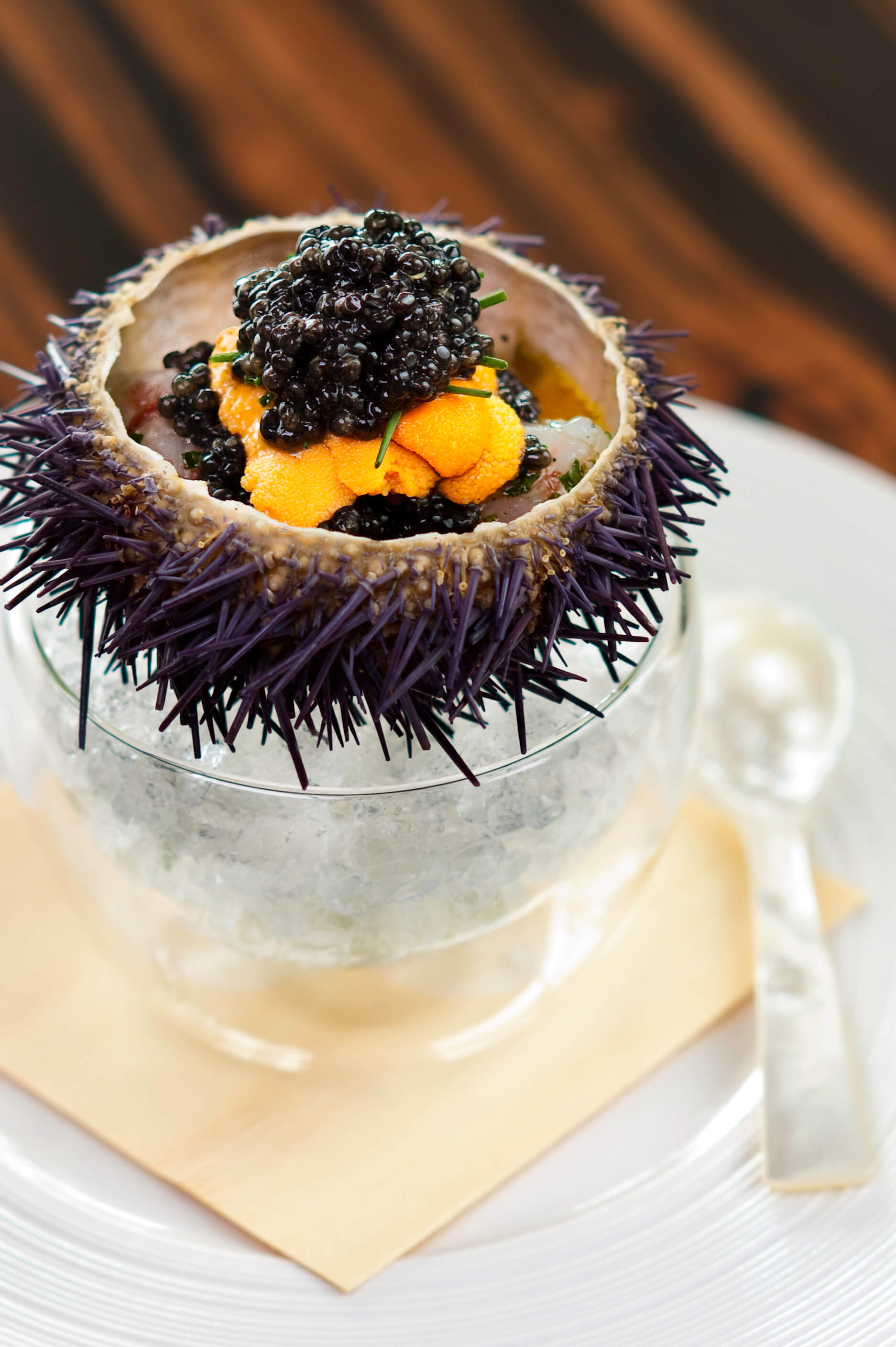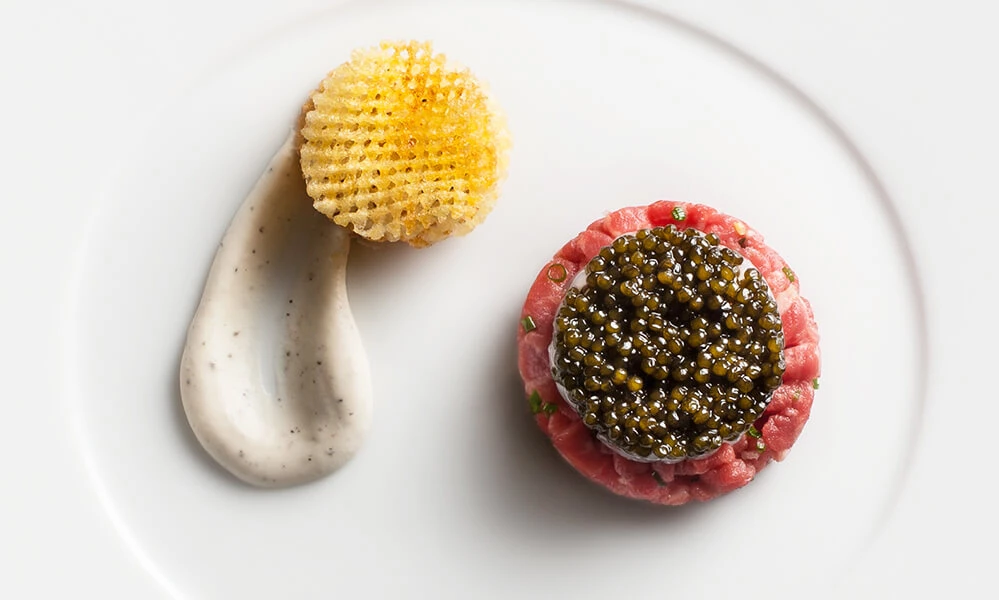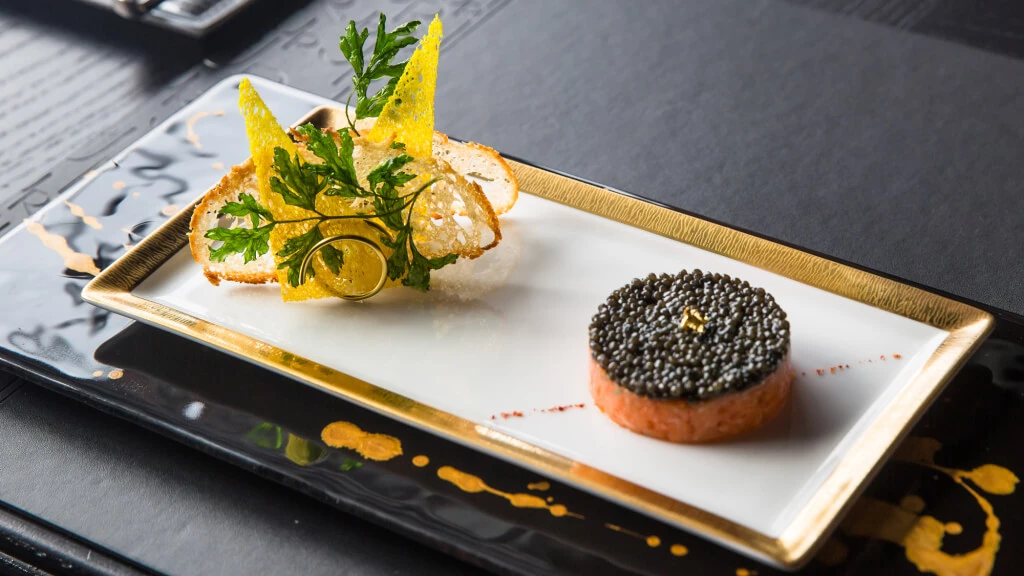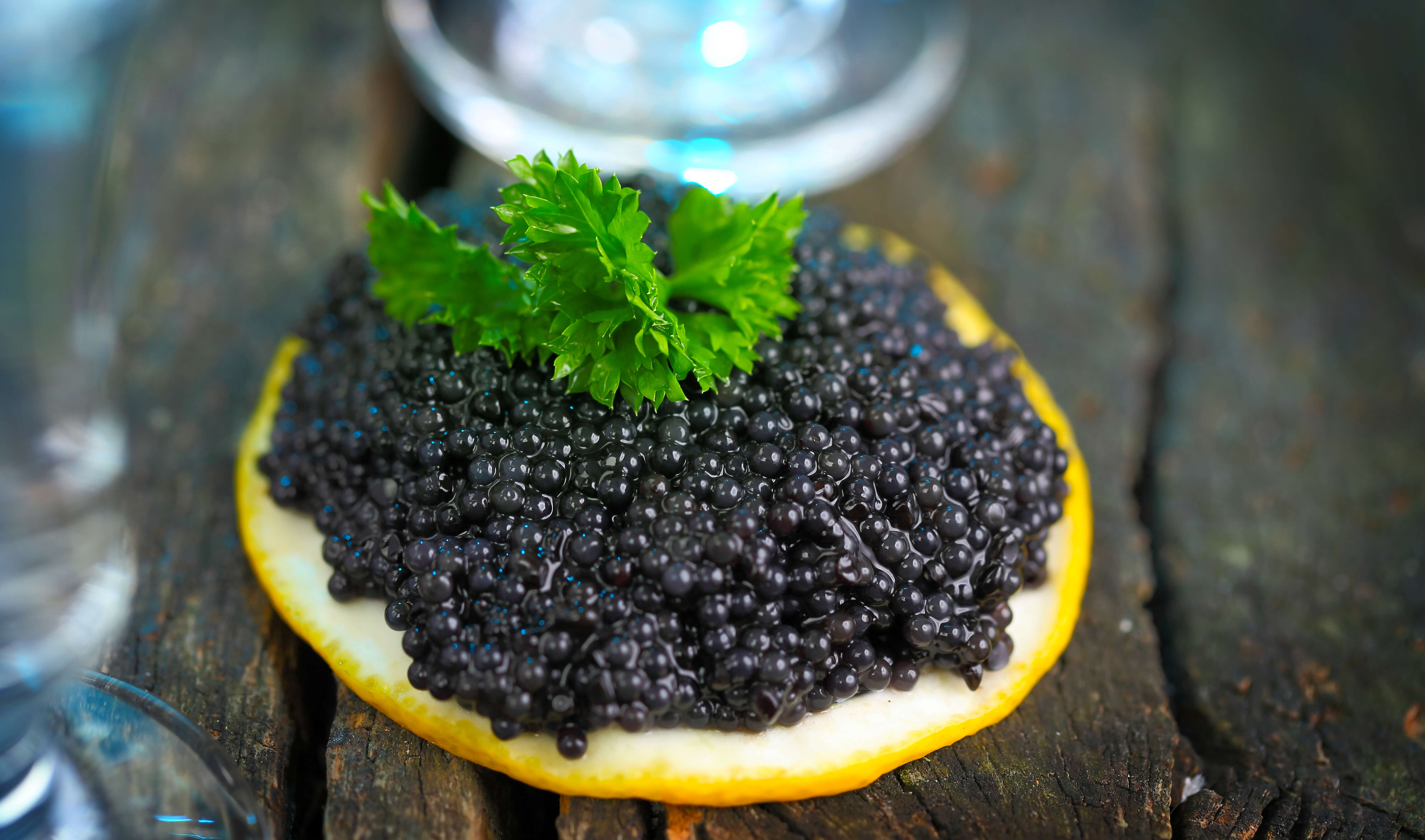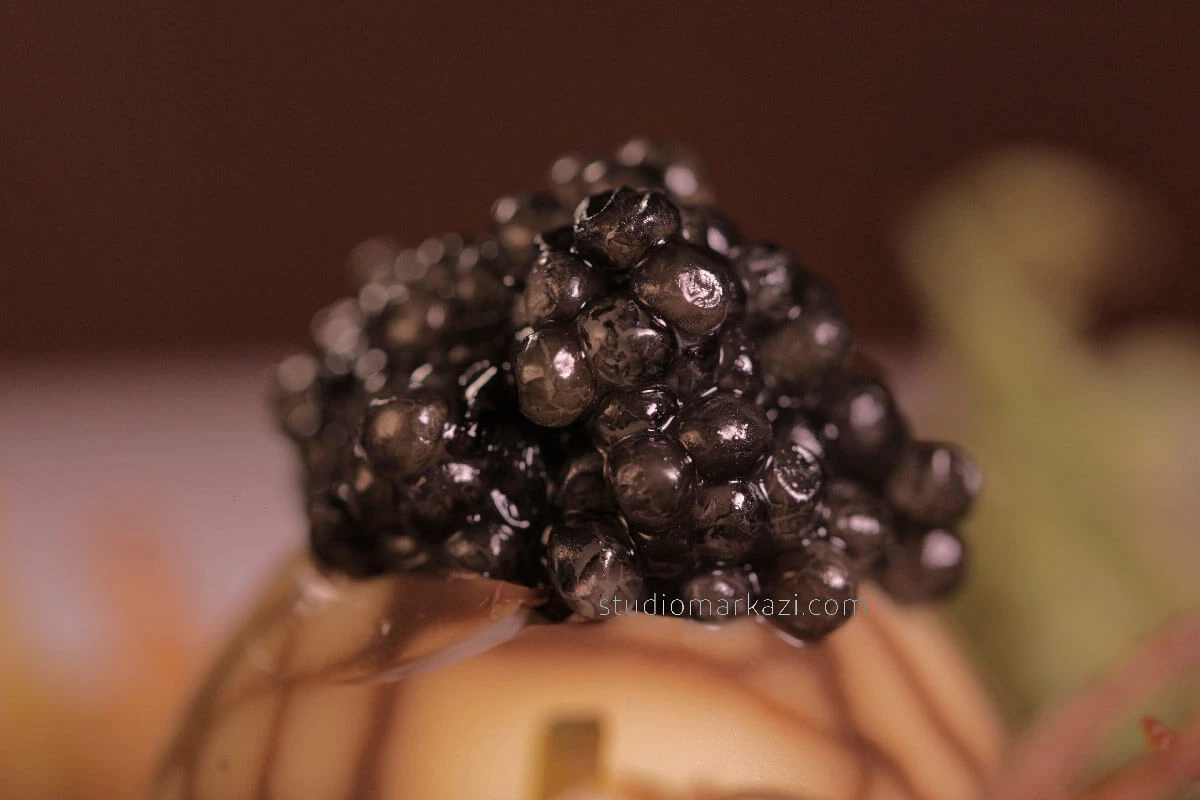The value of caviar processed from sturgeon roe is enormous. Sturgeon roe constituted by weight is the most expensive food on earth, and the Iranian Beluga and Iranian Almas being more expensive than gold.
The nutritional value of sturgeon roe is superior to fish flesh of other species. It always contains more proteins and fats. Roe has a pleasant, yolky taste. The eggs, enveloped in the ovarian sack, are by nature sterile.
We mentioned in our other article that the use of sturgeon roe for human consumption as a delicacy was popular throughout the Persian Empire as long ago as 2000 B.C. under the name Khavyar. Presently, fish roe extracted from other fish species such as Mullet, Salmon, Lumpfish or Tuna are incorrectly and illegally sold as “caviar“. To be sure, “caviar” must historically, legally and ethically, only refer to fish roe from the Sturgeon species. This guide will help you avoid being deceived by unscrupulous sellers (who will sell fake caviar with mislabeled products). It is necessary to define which preparations may be called caviar or caviar-imitation or substitute products.
In Europe, the United States and Canada the term caviar is legally reserved exclusively for the roe of sturgeon and not other fish. Misusing the word in those jurisdictions is a criminal offence. Roe derived from other fish must be called caviar substitute or imitation.
Often unscrupulous sellers illegally label and sell lumpfish or salmon eggs as Black or Red Caviar to create the impression that it is from the beluga, osetra or sevruga!
Some Sellers also falsely claim to be the biggest sellers of caviar when, in fact, they are merely large sellers of salmon roe or lumpfish and not sellers of high quality Caspian Beluga, Osetra, and Sevruga.
The Word Caviar and What is Means
Labeling of caviar products has a confusing history, and continues to be a matter for discussion and argument. The central issue is how to use the word caviar. The word itself is of Persian origin (خاويار) . It was first mentioned in the writings of Platina (1458), the Hofmeister of Pope Pius II. It occurs later in different documents of the 16th century in Italy, France, Spain and England. It has had a variety of spellings, pronunciations, and native modifications. In modern English, two pronunciations are accepted: caviár and cáviar (the accent indicates how the word is stressed). In Persian, the meaning of the word is “fish eggs”. You can read about the history of caviar here for more information.
The Russian word for caviar is ikra, the generic term used for both single fish eggs and for ovaries in the biological sense. It is also used to describe a wide range of products processed from sturgeons. The Japanese term ikura used for salmon caviar is actually derived from the Russian term. This term is used in Japanese only for separated, salted salmon eggs. Whole salted salmon ovaries are called sujiko. The respected Oxford English Dictionary contributes to the confusion:
Caviar – the roe of the sturgeon and other large fish obtained from lakes and rivers of the East of Europe, pressed and salted and eaten as a relish.
The Encyclopedia Britannica offers a similar version:
Caviar – processed salted roe of the sturgeon and certain other large fish prepared as an appetizer.
These definitions add to the semantic mess – why “large fish” or “pressed?”
The word caviar also has a figurative meaning.
“The play, I remember, pleased not the million, ’twas caviar to the general.” (Shakespeare’s Hamlet).
The word was used to stress that to enjoy caviar one has to acquire a taste for it; the “general” public is not able to appreciate the taste.
Nowadays the word is synonymous with exceptionally high quality, status, taste or value of both edible and non-edible items. In the play by Julius Horst entitled Caviar, one character describes a charming woman — “She is a caviar.”
Almost all languages use words derived from the word caviar.
Roe Products: The Difference between Caviar and Roe
Sturgeon roes consist of a pair of ovaries, which are the membranes or sacs holding the eggs. The eggs are connected to each other and to the sac by connective tissues, which progressively weaken as the eggs mature, so that fully ripe eggs will flow individually from fish, as they do when the fish spawn.
Sturgeon roes are processed into three groups of products: whole ovaries; paté and other culinary products; and caviar. Whole ovary products include whole or sliced ovaries which are salted, dried, marinated, smoked, fried, pressed or cured. Paté and culinary products include roes blended with salt, flavors, thickening agents or fillers and then pasteurized or cooked. Caviar are fish eggs separated from the connective tissue of the ovaries by passing through a mesh screen, salted, perhaps flavored, then pasteurized or perhaps pressed into sliceable cake-like loaves. A more detailed version of this definition of caviar is given in our Glossary. In simple terms, caviar and caviar type products are made from separate eggs. This is sometimes described as granular or grainy caviar. If it is pressed afterwards, it is called pressed caviar.
Caviar vs Roe
Caviar can be made from almost any kind of sturgeon roe of suitable size. Many adjectives are used with the word caviar. Some identify the product by sturgeon species: beluga, osetra, sevruga and Iranian baeri. Some indicate the water body where the fish was caught: Caspian, Persian Gulf. Still others describe process features: granular, pressed, flavored, pasteurized.
Product labeling practices must all comply with CITES regulations in addition to any further domestic laws which may differ from country to country.
CITES Labeling regulations also require declarations of net weight, country of origin of the product, species and the name and address of the packer or distributor.
Labels which contain words or expressions, figures or symbols that imply false information, or may reasonably be regarded as misleading or deceiving regarding the origin, technology or quality of the product are in violation of the regulations.
6 Tips to Avoid Artificial or Knock-off Caviar
1. Check the front AND the back of the tin
When you pick up a tin of caviar, not only should you look at the front, but you should turn it over and examine the back as well for the CITES label. It looks something like this:

The front of the tin is eye-catching but holds little information. The back of the tin is where you should focus your attention as not all caviar is made equally. After all, this is a premium product and you need to be sure what you’re getting.
Upon the back you will find the CITES label, CITES is robustly enforced worldwide by law.
The CITES information will tell you which the country the caviar came from. If you see “IR” or “RU”, you are holding caviar from the Caspian Sea (“IR” = Iran, “RU” = Russia) which is the highest grade available (this includes Almas). For these reasons you should rely on the CITES information. This is especially important for online purchases of caviar. The online store should display a clear and readable photograph of the back of the tin.
If you see any other initial in the Source Code, you’re not getting authentic, high quality caviar.
2. Don’t be fooled by phrases like “Persian Method”, “Iranian Method” or “Iranian Tradition”: It doesn’t mean it’s Caviar from Iran
Following on from the above point, you will see various caviar tins on the market where the front of the tin displays the above key phrases. This does not mean that it came from the Caspian Sea. The product is still caviar but perhaps sourced from artificial farms in China, France, Spain and Germany. Caviar from Iran and Russia is seen as the real and most authentic caviars.
In short, “method” does not imply “location” or “origin”. Always check the back the tin carefully
3. “Species matters” and “Location, location, location”
The pristine waters of the southern shores of the Caspian Sea have been home to the indigenous Sturgeon for tens of millions of years. This king of fish, which lived when the dinosaurs ruled the Earth, has remained unchanged but is now in critical danger due to its long breeding cycle (It takes roughly twenty years for a sturgeon to reach breeding age). Governments around the world sternly and with swift, harsh penalties, control and protect the Beluga, Osetra, and Sevruga from extinction.
Wild sturgeon may not be touched therefore all the caviar that you eat must be harvested from fish raised in farms. Only in Iran (caviar from Iran) is it possible to have farms that contain the waters of the Caspian Sea itself, the everlasting home of the Beluga, Osetra and Sevruga. It feeds off the phytoplankton indigenous to those waters. This cannot be transplanted – although many have tried and failed. Mother Nature cannot and will not be defeated by the arrogance of man.
For example, French farmers can take the caviar fish out of the Caspian, but they can never put the Caspian in France. It is unethical as well as against the principles of sustainability to remove them to far-off lands, to be factory farmed by those who can never understand what Caspian Beluga caviar truly means. Their expensive scientific instruments, their high technology just cannot surmount these problems. But they continue to try and fail, while charging you, the customer, for the privilege.
Farming sturgeon has a long lead time. It takes at least twenty years before a sturgeon (caviar) fish is ready to be harvested. This cannot be sped up and advances in science will never achieve this.
The 3 Most expensive caviars and their Source Codes
You’ll see tins labelled with many different names. Be sure to look for the species codes listed below. Put simply, if you don’t see them, you’re not enjoying top quality caviar.
| Common name(s) | Species | Native Habitat | Species Code |
| Beluga” | Huso Huso | Caspian Sea | HUS |
| Osetra | Acipenser gueldenstaedti | Caspian Sea | GUE |
| Sevruga | Acipenser stellatus | Caspian Sea | STE
|
| Persian Osetra | Acipenser persicus | Caspian Sea | PER |
4. Hybrid versus pure caviar
It is possible to determine the very sturgeon that the caviar was harvested from by reading the lot number. This means that you can buy every tin from a specific fish. Moreover, you can send a sample to a private laboratory for DNA testing (the original DNA results are permanently held by CITES scientists and are available for comparison).
Every tin can be accounted for via a worldwide computer database under the CITES system. What does this mean for you? It means that each tin is truly unique and there may be a total of one hundred tins from a specific fish.
You can tell from the CITES code on the tin if it is a hybrid or one single fish.
5. The rich and complex process of preparing the caviar at the source
Tens of centuries have gone into refining the method of making caviar delicious to the palate. It is part of the history of Persia and the southern shores of the Caspian Sea. Empires have come and gone, kings, moguls and czars have arisen and fallen but all have tasted the unique flavour that is now in our product.
Caviar is more than a passing delicacy, it has life-giving nutritional value. And the recipe has been passed down generation to generation within the families who have lived in this region for eons.
Today, although the exact steps are a secret, it is performed under strict scientifically control to ensure that you and the children of your children will enjoy the precisely same taste. It is quantifiable, objective and, most importantly, protected from the prying eyes of foreign producers. Only key individuals possess the knowledge and understanding. And they are and can only be proudly Iranian!
6. Pasteurization
All caviar must have a “Best Consumed By” date as would any perishable fresh fish or packaged food. This usually is placed on the container along with the lot number.
Most caviar from European farms has a lot of salt because the caviar is unable to reach the quality of caviar that comes from sturgeon from the Caspian Sea.
After all, why would you purchase premium “fresh caviar” without evidence of when it was harvested, packaged, or subject to expiration?
Artificial and Knock-Off Caviar
Popularity, high prices and growing demand for caviar type products on the one hand and uneven distribution of world roe resources on the other hand, stimulated food scientists and engineers to develop caviar imitations and knock-offs. A plethora of caviar farms have popped up in Europe and even China poorly attempting to imitate the pre-historic conditions of the Caspian Sea.
In recent years artificial caviar copy-cat technologies emerged in Spain, Japan and Israel. The aim was to imitate the two most valuable caviar types — Beluga and Osetra. The technological processes involved are often claimed to be novel and are patented. Many of them are based on well known particle or globule forming and encapsulation principles used in numerous food and pharmaceutical applications.
A traditional Spanish product for over two thousand years is sun-dried ovaries of the grey mullet or mújol. An artificial caviar knock-off produced by machinery in modern Spain is called “MújolShikran” . It contains about 40 percent gray mullet eggs. Other ingredients include herring and salmon eggs. Both frozen and fresh roes are utilized. Total yearly production is reported to be close to 100 tonnes, of which 25 percent is exported. The technological steps involved are as follows: mixing ingredients into a paste; adding gelatine; adjusting viscosity; forming ball-like particles (2 to 3 mm size) by means of a multinozzle machine using infrared thermotreatment; curing in flavored brine; drying to specification; packing; and pasteurization. This product has two specific properties to note. Firstly, there are artificial dyes, as the grayish-black color is not achieved naturally when the particles are thermotreated.
In Russia, two types of artificial caviar are processed caviar” on an industrial scale. The trade names are: “granular red caviar” and “protein caviar.” These products are consumed domestically. The granular red caviar is made from salted fish roe and milt, vegetable or fish oil, agar or gelatine, flavoring substances and coloring (carotenoids). It contains up to 10 percent protein and 20 percent fat. If pasteurized, it can be stored at -2° to -4°C (25° to 30°F) for up to 3 months. Unpasteurized, its shelf life is only 15 days.
The technological process involves the formation of globules which look similar to natural salmon eggs. Globule formation takes place when a pulsating oil jet strikes a cascading hot emulsion which forms the globule interior. Encapsulation follows when these emulsion-fat droplets fall into a cold solution and a film is formed around the globule.
The so-called protein caviar does not utilize ingredients of fish origin. It is perhaps the ultimate artificial caviar. It uses casein, a variety of modified proteins, chicken egg yolk, gelatin, tannin substances, artificial flavors and dyes. The size, taste and color of each capsule, which has a perfectly round shape, can be regulated to produce imitation (or artificial, whichever word is preferred) “salmon” or “sturgeon” caviar. Sugar and calcium salt instead of sodium salt are used. The capsules look amazingly similar to salmon eggs, having a distinct oil core inside each “egg”. This technology is ready to provide artificial caviar on a large industrial scale. Apparently, the market does not yet exist.
In Japan, the trade name for artificial salmon caviar is Imitation Ikura. The manufacturer claims refrigerated shelf life up to six months. The product can be incorporated into hot dishes
In Israel, artificial caviar is called “Kosher Caviar,” to stress that it is appropriate for consumption by observant Jews, who consider scaleless sturgeons as inedible fish. The low calorie imitation sturgeon caviar utilizes fish, vegetable oil and other natural ingredients. Artificial coloring is not vegetable used. Declared shelf life at refrigerated temperatures is five months.
How is Caviar Made
Processors, distributors, retailer and restaurant outlets and consumers all have similar interests in being able to judge the quality of caviar products. Processors and distributors are most likely to have access to laboratory equipment and food technologists so are best able to control and determine quality. Consumers have little to help them except their eyes, noses and palates. Nevertheless, these are powerful tools when backed with knowledge of the products. This chapter discusses mainly quality issues as they relate to the processor and distributor. It may also be of some interest to consumers.
Earlier above, we argued that caviar processing is not an art. However, because of the wide range of characteristics of raw material and processing conditions, making caviar requires great skills. In Russia, caviar makers (men are called ikrjanschik and women ikrjanschitza) are highly experienced and respected professionals. In this book, we have given guidelines to such important factors as the quality of ovaries and the duration of the salting process. Nevertheless, the final decisions about these and other important matters are subjective, made by experts utilizing their knowledge and experience.
The table shows critical quality checkpoints for caviar processing and the factors that must be assessed at each point.
Sturgeon ovaries must first be graded by maturity and freshness. Then they are graded by color into four categories: light gray, gray, dark gray and black. Next, eggs are size graded into one of three sizes. After the eggs are screened, the caviar maker must decide whether they are clean enough or whether they require another rinse. While the eggs are being salted, he must determine how long to continue the process to ensure the correct levels of salinity and viscosity. The test-salting method described in Chapter Four for the brine salting of salmon eggs is hardly applicable to sturgeon egg salting because these are dry salted in small batches of five to 15 kilos. Eggs from each fish are salted separately and there is no opportunity to perform test-salting routinely. Quality checks on issues listed in the table are rarely supported by scientific tests, but depend on the skill and judgement of the caviar maker.
| Caviar processing quality checkpoints | |
| Operation | What is checked |
| Extraction of ovaries | Fish quality. Fish bleeding. Provisions to obtain intact and clean ovaries: washing off slime, ovaries detached of ovaries transported immediately for rinsing. |
| Ovaries rinsing | Water quality and temperature, light brine concentration, short duration and thoroughness of rinsing. |
| Ovaries grading | Poor quality is outgraded and the rest is divided in batches with an equal grade. Grading by color, size, strength and elasticity of membranes. Smell. |
| Screening | Ovary temperature is sufficiently low, absence of impurities, frequent change of screens and removing of debris, volume of broken eggs. |
| Salting | Salt-preservative ratio for dry salting. Adequacy of salting time for brine salting and weight of salt to achieve desired salinity, for dry salting. Brine concentration (density) and temperature, brine cleanliness, brine/egg ratio. |
| Draining | Brine uptake, caviar dryness, interior egg viscosity, exterior stickiness of egg mass. Dryness, temperature and cleanliness of room, air ventilation, absence of foreign smells, thickness of egg layer put for draining. |
| Packing | Vegetable oil type and quality, sufficient head space for vacuum packing, level of vacuum, container sterilization temperature, highest sanitation standards for tools, room, people; dense filling without air cavities into the container, check weighing. Container integrity and outside cleanliness. |
| Pasteurization | Water temperature fluctuations, cooling water temperature, container integrity, container body cleanliness outside |
| Storage | Appropriate freezing or storage temperature, humidity. |
| General | Keeping fisheries processing records for batches by fish (for sturgeons) or by processing – packing dates (for other caviar), labelling requirements, general sanitation. |
| Note: The methods of control, the instruments used and frequency of checks are determined by each individual processor for each operation and depend on the specific circumstances. | |
Salmon ovaries are also graded by maturity and freshness, but are not distinguished by size or color (note that eggs from different species should not be mixed together). After the eggs are screened, the caviar maker must decide whether they are sufficiently free of debris and broken eggs, or whether they must be run a second time over the sloping screen. As opposed to the case with sturgeon caviar, the vital decision on how long to continue brining must be based on the test-salting experiment, which is routinely repeated when egg quality or other conditions change.
Yield is vital to processors. Salmon roes yield about 75 to 80 percent of their weight as caviar. Sturgeon roes may yield as much as 85 to 90 percent. Yields from whitefish, lumpfish and other caviar raw materials vary, depending on whether screening is done manually or mechanically.
Yield is not simply the total weight of product. The processor’s profits also depend on the quality grades of the product, since prices vary widely for different quality grades. If the caviar maker allows soft or sticky ovaries to remain with the best ones, then the resulting batch will all be second grade product, earning less than if the initial quality grading had properly segregated the roes.


